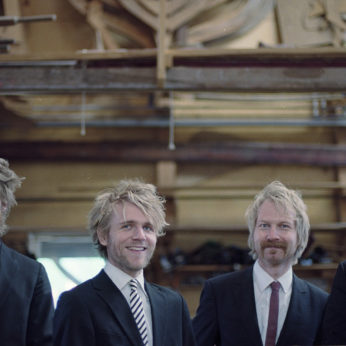Composer: Arvo Pärt (b. 1935)
Performance date: 03/07/2010
Venue: St. Brendan’s Church
Composition Year: 1985/89
Duration: 00:09:16
Recording Engineer: Anton Timoney, RTÉ lyric fm
Instrumentation Category:String Quartet
Artists:
Danish Quartet (Frederik Øland, Rune Sorensen [violins], Asbjørn Nørgaard [viola], Fredrik Sjölin [cello]) -
[quartet]

The Estonian composer, Arvo Pärt, has
become something of a cult figure ever since his Tabula Rasa
CD was brought out by ECM in the early eighties, a CD that included
one of the early versions of Fratres. In the late sixties and
early seventies Pärt had totally changed his style of composition.
He had made a study of Gregorian chant, the contrapuntal works of the
Renaissance masters and Russian Orthodox chant and under their
influence he radically simplified his style. He called his new style
tintinnabulation, from the Latin word for bells. Tintinnabulation
is an area I sometimes wander into when I am searching for answers –
in my life, my music, my work. In my dark hours, I have the certain
feeling that everything outside this one thing has no meaning. The
complex and many-faceted only confuses me, and I must search for
unity. What is it, this one thing, and how do I find my way to it?
Traces of this perfect thing appear in many guises – and everything
that is unimportant falls away. Tintinnabulation is like this. Here I
am alone with silence. I have discovered that it is enough when a
single note is beautifully played. This one note, or a silent beat,
or a moment of silence, comfort me. I work with very few elements –
with one voice, with two voices. I build with the most primitive
materials – with the triad, with one specific tonality. The three
notes of a triad are like bells. And that is why I called it
tintinnabulation.
This new style led to astonishing
success for Pärt’s music, which seems to have struck a chord in an
age when people need a point of repose in otherwise hectic lives. The
listeners’ desire to find something in his music deeper than mere
diversion coincides with Pärt’s conviction that he is offering an
experience of peace, beauty and simplicity as antidotes to the
complexity of modern life. Its meditative aspect along with its
oppressive but comforting melancholy seems to be a characteristic of
contemporary Eastern European art in general.
Fratres exists in several
different versions. The original work dates from 1977 and was scored
for twelve parts (winds, strings, claves and tom-tom). It is probably
best-known in the piano and violin version.. The version for string
quartet dates from 1989 and is particularly austere. Throughout the
work the second violin holds down a continuous chord, and against
this drone the other parts move stepwise and in parallel motion, as
if evoking the chanting of medieval monks. In addition the first
violin and viola have a scordatura tuning, their lowest string being
tuned a major third and major second lower than their normal tuning.
This provides a richer sonority in the middle and lower ranges of the
quartet. The music has a near hypnotic quality, achieved through a
wave-like repetition of the musical phrases.
Copyright © 2024 West Cork Music. All rights reserved.
Designed and developed by Matrix Internet